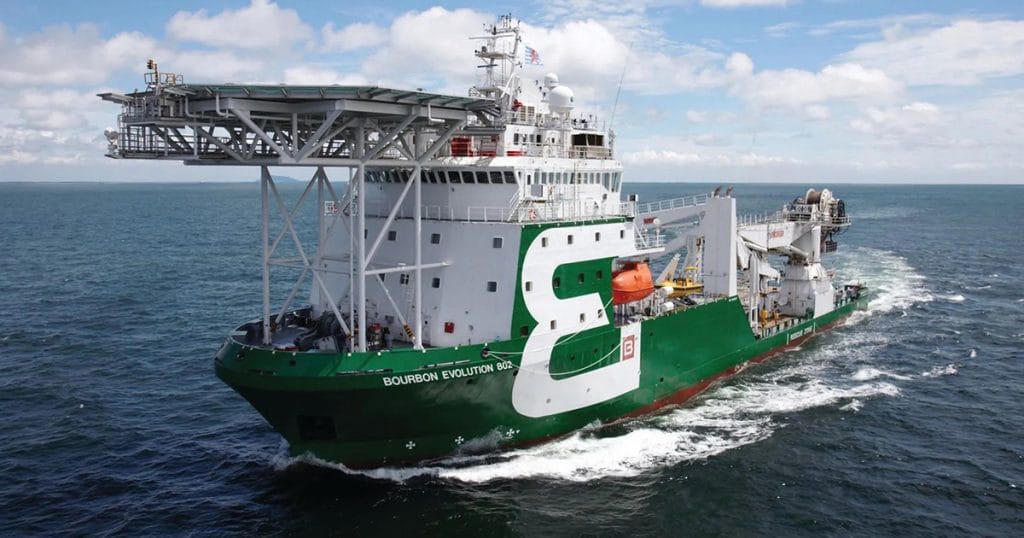
Today’s offshore scenarios, in increasingly deeper waters, push DP systems far beyond simple station-keeping. Environmental volatility, degraded GNSS signals, and dynamic vessel movements demand control architectures that respond within milliseconds with not only accuracy but resilience. This article shares a systems engineering perspective on building DP support technologies designed to meet these challenges, drawing from Exail’s real-world experience in navigation, inertial, and acoustic positioning.
HIGH-STAKES OFFSHORE CHALLENGES
Vessels involved in offshore construction, inspection, or subsea intervention regularly face rapidly changing forces from wind, waves, currents, and mechanical loads. Maintaining station in these conditions requires swift and precise corrections across multiple axes—surge, sway, yaw, and pitch.
Thrusters provide the physical force, but their effectiveness depends on timely, consistent data about position, heading, velocity, and rates of change. When primary inputs like GNSS degrade due to interference, signal shadowing, or spoofing, the system’s stability relies on how well alternative navigation sources can fill the gap. Resilient architectures that combine high-performance inertial navigation, acoustic tracking, and deterministic data fusion become essential to ensure continued control.
INERTIAL NAVIGATION
A stable, accurate heading and motion reference is essential to any DP system. However, GNSS-based heading solutions are particularly vulnerable near large structures, in high latitudes, or during signal disruptions.
Exail’s Octans 9 Attitude and Heading Reference System (AHRS) provides this critical layer of resilience. Based on fiber-optic gyroscope (FOG) technology, Octans 9 delivers high-accuracy heading (0.1° secant latitude RMS without GNSS, 0.05° RMS with GNSS) and motion data independently of satellite or magnetic inputs. Its advanced filtering and dynamic alignment algorithms ensure dependable and secure performance even in challenging marine environments. Octans 9 also features a GNSS rejection mechanism that allows it to operate stand-alone when GNSS data becomes unreliable. Certified to MED/IMO standards and rated as survey-grade, it serves as a robust inertial core for demanding offshore operations such as lifting, pipe-laying, or wind turbine installation.

For operators looking to extend beyond attitude and heading, Exail’s Phins inertial navigation system (INS) provides full position and velocity tracking, combining inertial sensing with external inputs such as Doppler logs or acoustic references. Designed for integration with dynamic positioning systems, Phins enhances DP performance by ensuring accurate and stable navigation data during GNSS outages or degraded conditions. It is particularly suited for coupling with Exail’s Gaps Series USBL systems, creating a tightly integrated solution where acoustic and inertial data reinforce each other. This configuration ensures navigation continuity and integrity, even in complex subsea environments, offering an advanced solution for operators seeking deeper levels of DP system resilience.
REAL-TIME TRACKING & REFERENCING
Precise vessel control depends on real-time referencing. When GNSS signals are weak or absent, such as near platforms or during subsea operations, acoustic systems like USBL become critical.
Exail’s Gaps Series USBL systems provide a relative positioning reference between the vessel and fixed acoustic beacons deployed on the seabed. This enables the DP system to maintain position relative to a known and stable point, even in full GNSS denial. Featuring a unique 3D acoustic array and embedded inertial navigation, Gaps systems offer full hemispherical coverage for station keeping in shallow or deep-water areas. This fusion ensures accurate positioning during vessel movement or in harsh sea states.

Beyond DP referencing, Gaps Series also supports real-time tracking of subsea assets such as ROVs, structures, and towed equipment, providing critical situational awareness in complex underwater environments from deepwater drilling to offshore wind farms.
SMART DATA FUSION
DP systems gather data from diverse sensors, including GNSS receivers, inertial navigation systems, Doppler velocity logs, acoustic beacons, and gyrocompasses. The challenge lies not just in collecting this data, but in integrating it coherently while ensuring its integrity.
Exail’s Netans N1 data distribution unit acts as the central nervous system of this architecture. By applying deterministic data fusion, precise time-stamping, and continuous integrity checks of all sensors, Netans N1 delivers validated and synchronized information to the DP controller, even amid fluctuating or degraded sensor inputs. The system emphasizes data confidence over redundancy, prioritizing consistency and robustness to ensure stable vessel behavior, even when individual sources are compromised.
SEAMLESS TECHNOLOGY INTEGRATION
While inertial, acoustic, and satellite navigation technologies each play crucial roles in dynamic positioning, the true advantage emerges when these technologies are integrated within a unified and coherent architecture. Exail’s mastery of all three domains, developed entirely in-house, enables tight coordination between systems, from hardware to real-time data fusion. This vertical integration enhances not only the resilience of each component, but also the overall performance of the navigation chain. By enabling seamless interaction between systems such as Octans 9, Phins, and the Gaps Series, Exail offers a configuration where navigation data remains coherent and reliable, even when GNSS inputs are lost or compromised. This integrated approach empowers vessels to maintain accurate position and heading in highly dynamic or constrained environments without disruption.

Leading offshore operators such as Bourbon and Oceaneering, long-standing partners of Exail, have adopted these solutions to ensure continuous performance in the face of harsh offshore realities. For them, combining these technologies within a single, vertically integrated system means gaining the robustness and responsiveness needed for critical operations, from deepwater construction to subsea intervention. As DP systems continue to evolve toward higher levels of autonomy and adaptability, the ability to rely on harmonized, internally developed technologies positions Exail’s solutions as a resilient foundation for the future of offshore navigation.
This feature appeared in ON&T Magazine’s 2025 June Edition, Deep-Sea Exploration, to read more access the magazine here.








